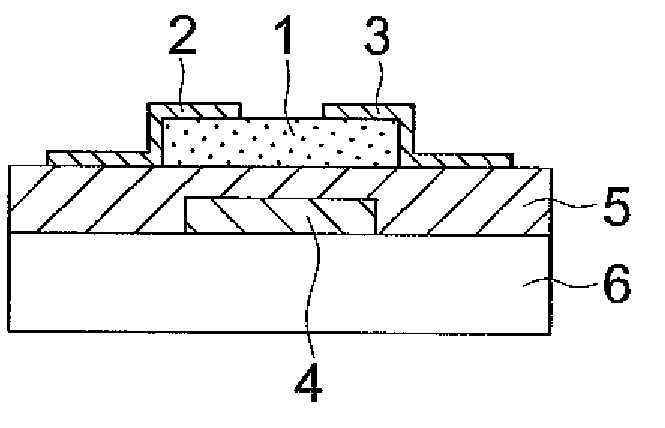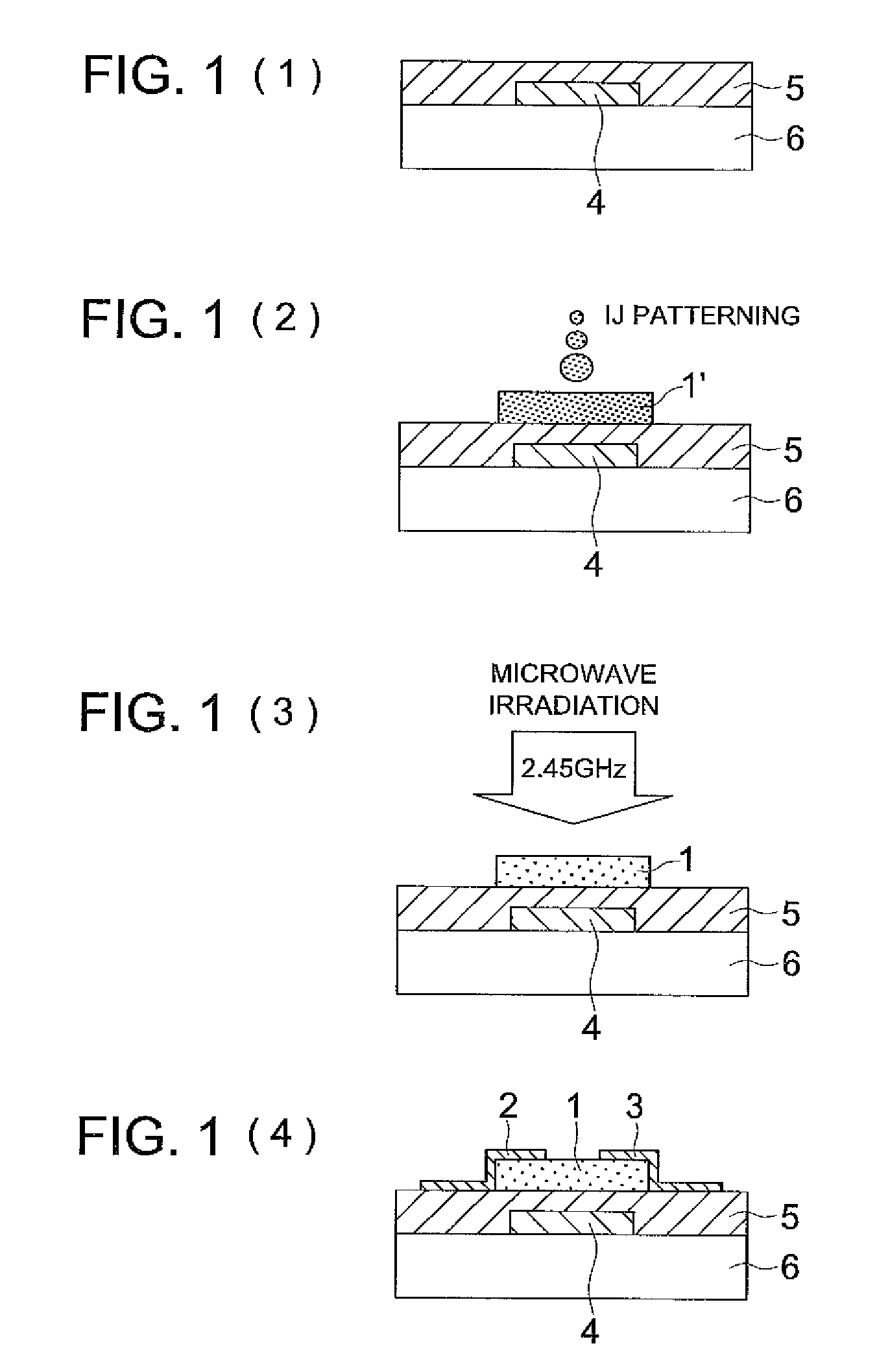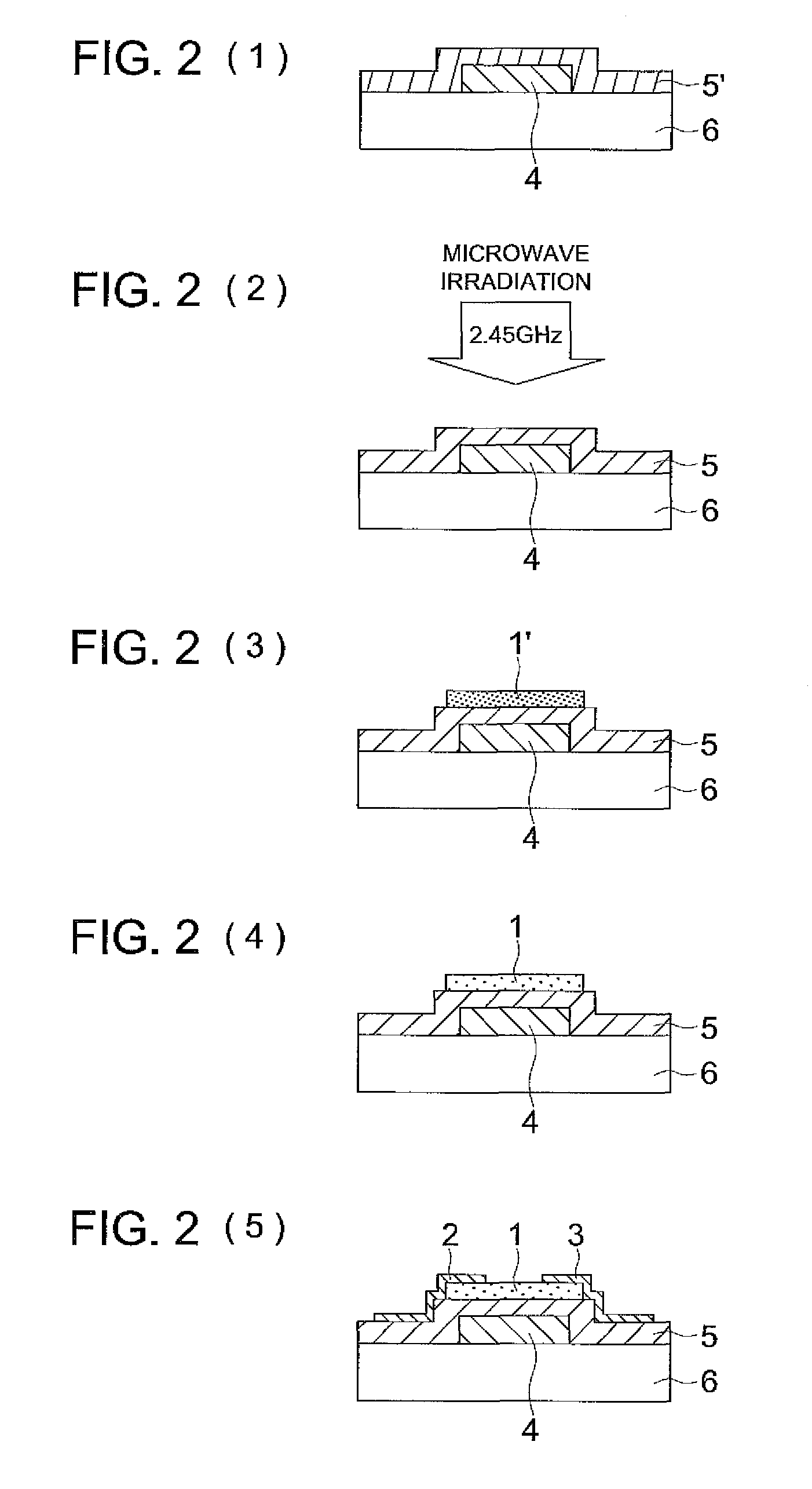Electronic device and method of manufacturing the same
a manufacturing method and electronic technology, applied in the direction of semiconductor devices, basic electric elements, electrical equipment, etc., can solve the problems of difficult application of light and flexible resin substrates, relatively long processing time, energy efficiency, etc., to improve the mobility of carriers and improve the on/off ratio, the effect of improving the production efficiency and the property
- Summary
- Abstract
- Description
- Claims
- Application Information
AI Technical Summary
Benefits of technology
Problems solved by technology
Method used
Image
Examples
example 1
Example of Thin Film Transistor Having Bottom Gate-Top Contact Structure
[0291]In FIGS. 1(1)-1(4), schematic cross-sectional views illustrating the manufacturing process are shown.
[0292]As substrate 6, a glass substrate was used, and an ITO film was formed on the substrate by sputtering. Then, the ITO film was subjected to patterning to form gate electrode 4 (100 nm in thickness).
[0293]Subsequently, gate insulation layer 5 constitute of 200 nm thick silicon oxide was formed by an atmospheric pressure plasma CVD method (FIG. 1(1)). The atmospheric pressure plasma treatment apparatus disclosed in FIG. 6 of JP-A No. 2003-303520 was used.
(Gases Used)
[0294]Inert gas: helium 98.25% by volume
[0295]Reactive gas: oxygen gas 1.5% by volume
[0296]Reactive gas: tetraethoxysilane vapor (bubbled with helium gas) 0.25% by volume
(Discharge Conditions)
[0297]High frequency power source: 13.56 MHz
[0298]Discharge power: 10 W / cm2
(Electrode Conditions)
[0299]The electrode is a grounded roll electrode havin...
example 2
Manufacturing of Thin Film Transistor 201
[0306]A transistor was Manufactured in the same manner as in Example 1.
(Formation of Semiconductor Precursor Thin Film)
[0307]Indium nitrate, zinc nitrate and gallium nitrate were mixed in a molar ratio of 1:0.1:0.5 and dissolved in water (a mixture of water / ethanol=9 / 1 in mass ratio) to form a 10 mass % aqueous solution, which was then used as an ink for inkjet printing to eject the solution onto a channel formation area, followed by drying by heating at 150° C. for 10 minutes to form semiconductor precursor material thin film 1′ was formed (FIG. 1(2)).
[0308]By conducting microwave irradiation under the same condition as in Example 1, semiconductor precursor material thin film 1′ was transformed into semiconductor layer 1 in the same way as above due to the thermal oxidation with the heat transferred from the electrode.
[0309]Subsequently, the source electrode and the drain electrode were formed in the same manner as in Example 1 to obtain thi...
example 3
[0331]In FIGS. 2(1)-2(5), schematic cross-sectional views illustrating the manufacturing process are shown.
[0332]As substrate 6, a glass substrate was used, and an ITO film was formed on the substrate by sputtering. Then, the ITO film was subjected to patterning to form gate electrode 4 (100 nm in thickness).
[0333]Next, Aqua Micah NN110 (perhydropolysilazane / xylene solution: produced by AZ Electronic Materials) was applied on the substrate by a spin coat method (3000 rpm×30 sec), followed by drying to obtain insulating film precursor layer 5′ (200 nm in thickness). FIG. 2(1)
[0334]Microwave irradiation was carried out in the same manner as in Example 1, namely, Next, Aqua Micah NN110 (perhydropolysilazane / xylene solution: produced by AZ Electronic Materials) was applied on the substrate by a spin coat method (3000 rpm×30 sec), followed by drying to obtain insulating film precursor layer 5′ was formed (200 nm in thickness). FIG. 2(1)
[0335]Microwave irradiation was carried out in the s...
PUM
| Property | Measurement | Unit |
|---|---|---|
| temperature | aaaaa | aaaaa |
| temperature | aaaaa | aaaaa |
| temperature | aaaaa | aaaaa |
Abstract
Description
Claims
Application Information
 Login to View More
Login to View More - R&D
- Intellectual Property
- Life Sciences
- Materials
- Tech Scout
- Unparalleled Data Quality
- Higher Quality Content
- 60% Fewer Hallucinations
Browse by: Latest US Patents, China's latest patents, Technical Efficacy Thesaurus, Application Domain, Technology Topic, Popular Technical Reports.
© 2025 PatSnap. All rights reserved.Legal|Privacy policy|Modern Slavery Act Transparency Statement|Sitemap|About US| Contact US: help@patsnap.com



